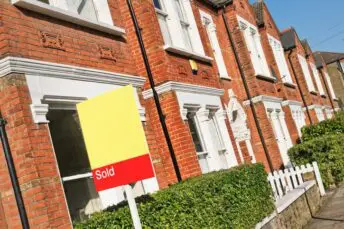House Price Watch Feb 2022
Average annual house price growth hit a record 11% in February -- the highest rate since our report began in Jan 2013. It is somewhat unexpected that the market has maintained momentum given 30 year high inflation, rising interest rates and stretched housing affordability. The drive for space since the pandemic is still in play with house price growth for detached homes significantly higher than for flats. However, with events in Ukraine, inflation could rise further and potentially shake consumer confidence. Looking ahead, we expect activity and house price growth to return to more usual levels.
What’s happening nationally
House prices are up on average +0.9% in the past month and +11% in the past year.
Indices based on:
Land Registry – registered property transactions in January.
Nationwide & Halifax – mortgage valuations in February.
Rightmove – asking prices posted on Rightmove in February.
*Rightmove is not included in the index average as the basis for its index is different (asking price vs agreed sale price)
| Index reports: | Monthly change | Annual change |
|---|---|---|
| Land registry | +0.4% | +9.6% |
| Nationwide | +1.7% | +12.6% |
| Halifax | +0.5% | +10.8% |
| Rightmove | +1.2% | +9.5% |
| Average change | +0.9% | +11.0% |
House prices in your area
Monthly changes in house prices have been mixed over the past month with some areas seeing a continued rise and others seeing a decline.
However, most areas of the UK have seen a rise in annual house price growth of 10% or more over the past year. The exceptions are the North East (+8.3%), Yorkshire & Humber (+7.3%) and London (+2.2%).
Average house prices are highest in London and lowest in the North East.
House price growth also varies by property type. Detached homes have seen the biggest rise over the past year (+12.6%) and flats/ maisonettes the smallest (+5.1%) according to Land Registry data. This may reflect regional price differences (more flats in London), as well as, higher demand for bigger properties and fewer properties of this type available for sale over the past year.
The latest cities house price data has yet to be released by Hometrack. City house prices are December 2021 figures.
| UK Region | Average price £ | Monthly change | Annual change |
|---|---|---|---|
| England | |||
| Nothern Ireland | |||
| Scotland | |||
| Wales | |||
| North West | |||
| Yorkshire and The Humber | |||
| North East | |||
| West Midlands | |||
| East Midlands | |||
| South West | |||
| East of England | |||
| South East | |||
| London |
| UK City | Average price | Annual change |
|---|---|---|
Market Monitor
February transactions were up 4% on January but down 21% on February last year. However, by historical standards, transaction levels are higher than normal for this time of year (higher than they were in February 2020 or February 2019).
It continues to be a seller’s market with average stock levels near the 12 month low.
Time to sell dropped to 36 days in February on par with the quickest months of the last 12 months.
How busy is the market?
- Not busy
- Normal
- Very busy
- Transactions lower than last February but higher than 2020 and 2019 levels
- Total transactions in Feburary 112K
- +4% from last month
- -21% lower than February last year
Homes for sale vs homebuyers
- Good availability of homes
- Normal
- Shortage of homes
- Buyer enquiries up (+17% RICS); buyer demand continues to rise
- Seller enquiries down (-4% RICS); stock levels close to historic lows
- Average stock per agent 41; up slightly (incl under offer/ Sold STC Rightmove)
Average speed of sale
- Fast
- Normal
- Slow
- 36 days to find a buyer down from 44 days last month (12 month average 40 days Rightmove)
What the experts say
Rightmove

“February proves to be even stronger than January. February normally sees a rise in asking prices from January, but this is the biggest monthly jump in cash terms recorded by Rightmove in more than twenty years and the annual rate of asking price growth is the highest recorded since September 2014. The pandemic continues to influence many home moves, with this month’s price growth driven primarily by the “second stepper” sector – those who may find themselves in need of more space and are now ready to move on from their first homes. The rising cost of living is undoubtedly affecting many people’s finances, especially those trying to save up enough for a deposit to get on the ladder or to trade up. Despite rising costs and interest rates, the data right now shows demand rising with many people determined to move as we head into the spring home-moving season.”
Nationwide

“The price of a typical home rose £29K over the past 12 months — the largest annual increase in cash terms since the start of the index in 1991.The continued buoyancy of the housing market is a little surprising, given mounting pressure on household budgets from rising inflation, which reached a 30-year high of 5.5% in January, and borrowing costs have started to move up. The squeeze on household incomes has weakened consumer confidence and housing affordability is more stretched. A typical home is now equivalent to 6.7 times average earnings, up from 5.8 in 2019. Inflation could rise further as events in Ukraine threaten to send global energy prices even higher. It is likely the housing market will slow in the quarters ahead. The squeeze on household incomes is set to intensify, with inflation expected to rise above 7% in the coming months.”
Halifax

“This was an eighth successive month of house price growth, as the market shows little sign of easing. Year-on-year prices saw the fastest pace of annual growth since June 2007. Lack of supply continues to underpin house prices, with a dearth of new properties being listed. This may be a particular issue at the larger end of the market. Over the past year, the average price of detached homes has risen at a rate more than four times that of flats in cash terms. Looking ahead, the war in Ukraine is a human tragedy, but is also likely to have effects on confidence, trade and global supply chains. Inflation – already at a 30-year peak – will remain higher for longer; squeezing already stretched household incomes. These factors are likely to weigh on buyer demand as the year progresses, with market activity likely to return to more normal levels and an easing of house price growth to be expected.”
RICS

“New buyer enquiries and agreed sales pick-up in February. New sales instructions are broadly stable albeit this follows a prolonged negative stretch. Stock levels therefore remain low, contributing to continued strong house price growth. The prospect of further interest rate rises is a factor that could begin to dampen growth in activity to a certain extent as the year wears on.”




